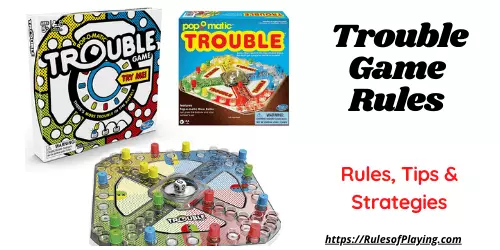If you are looking for simple yet amazing fun to maximize fun, wonder, and creativity, here comes the trouble game for you!
And mind that! there’s no trouble in playing the trouble! With unique dice in the center of the board (Pop-O-Matic), the game is loaded with the simplest rules and strategies.
Here is how we unfold silently trouble game rules, types, skills & strategies how to play
trouble without the trouble.

What is Trouble Board Game?
Contents
Trouble is an easy board game for 2-four gamers that calls for a specialized board containing a pop-dice roller (referred to as POP-O-MATIC).
Related Post: How to Play Four Square? Game Rules & Instructions
Game Components
- Plastic game blocks with POP-O-MATIC.
- Game board.
- Four rubber feet.
- 16 plastic game pins.
- Dice.
The object of the Game
Take the lead in moving four colored pegs on the field and reach the finish line. In order to win the game, you have to try to return the opponent’s pegs to Home.
The Game Setup
When the game begins, each player chooses 4 pegs of the same color. Then he places them in the matching color Home.
If there are only two people playing, each one of them can use two sets of pegs to play the game as desired.
Each player rolls the POP-O-MATIC button once to roll the dice and then releases it.
The players try to win the game by scoring more than the opponent. Finally, the player with the highest number ranks first. In this way, the game continues to the left of the first player.
Trouble Game Rules & Requirements
- Choose a color and region to place your pegs.
- Now put all 4 of your colored pieces in your “Home” spot.
- Roll the dice to decide which participant is going first.
- The participant with the very best role is going first, and the play proceeds clockwise (to the left).
- Moreover, trouble game guidelines state that to move your pieces from Home to Start, you have to roll a 6.
- If you do not roll a 6, and no pieces are in play, then your turn is over.
- You have to move one or more pieces from Home to Start.
- Once you do this, you pass your pieces around the board based on the number rolled on your turn.
Strategies/ Moving the dice.
- Whenever you rotate the dice, and digit 6 appears, you have to move/play the dice and move your pieces again.
- The best thing about this game is that it does not have a penalty for rolling multiple 6s in a row.
- While playing, the pieces circulate across the board clockwise/left.
- The contestant has to be alert about the space, whether it is free or occupied.
- So, you have to count every space you move.
- Sometimes you’re able to land on a space that has an opponent’s piece.
- In that case, your opponent’s piece is set to return to your opponent’s home.
- This incorporates the other contestant’s piece being on your “Start”.
- While you roll a 6 and can move a piece from “Home” to “Start.”
Rules to move the peg
When throwing the dice, you can move the peg on the play area and track the number of spaces indicated on the dice.
Move the peg clockwise along the playing track, and calculate whether each place is empty or full.
If you scroll 6, you can move the new peg out of the home.
You can also move a peg on the currently playing track.
After moving the peg once across the board, it will hit the FINISH line of the corresponding color.
Remember, the peg/piece cannot be bypassed more than once on the board.
Only when you move to the finish line and land with the EXACT NUMBER in the blank area of FINISH the peg can enter FINISH.
If you can’t and don’t have another peg to move, it’s the next player’s turn.
The player’s peg cannot be moved to another player’s FINISH LINE.
The players can move Pegs within a FINISH area only according to the directions of the arrows and by the exact dice count.
To win the Game
To win the game, you have to follow the rules of the game.
You must be the first player to make all the pieces into the final destination.
Moreover, you must spin the demanded number to get the pieces into the vacant finish location/mark.
If you roll more dice than can be moved, the turn is over and your piece will not move.
So, you don’t have to move any other pieces.
The pieces will not move again on the board once they have passed through it.
In “Finish” mode, if there is empty space, you can move a block further to the target area, and then scroll the exact number to move the piece to an available position.
If there are 3 or 4 people playing, you can continue the game after one of them wins.
It helps to determine second and third place.
Related Post: Playing Sorry Fire & Ice Game; Tips & Strategies
FAQs
1. What if a player rolls a 1 in trouble?
If someone “rolls” the red number, the player’s turn is over, and everyone else can move the new marker on the playing field. This action speeds up the game.
2. What do the X’s mean in trouble games?
An X means a troubled space. So if you land in XX, the Double Trouble space, you’ll take another turn. But remember if the roll of 6 causes double trouble, all you need is one extra move, not two.
3. What does a red 1 mean in trouble?
Red 1: Indicates that other players can participate. You don’t keep going on this turn. But If you stop on a double X, you get another turn.
